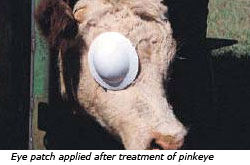‘Pink-eye’ in cattle causes concern in the Centre
Jocelyn Coventry and Meg Humphrys
With all the extra flies that have been around lately in ghastly hot weather, there has been some concern and discussion amongst local producers about ‘pink-eye’ in cattle. The following article provides a timely summary from two references about ‘pink eye’ in beef cattle (see internet links at end of article):
- to explain what local producers have been seeing
- to highlight management strategies.
Background
A study by Meat and Livestock Australia (MLA) reported that ‘pink-eye’ in cattle (infectious bovine kerato-conjunctivitis) costs Australian Beef Producers $23.5 million annually in lost production and treatment costs.
‘Pink-eye’ in cattle is an eye infection that starts as ‘weeping’ with inflammation, and can finish with ulceration and abcessation of the cornea. Infection by the primary bacteria (Moraxella bovis) occurs in association with many viral, bacterial and physical (environmental, animal) risk factors. Some of the physical factors that predispose cattle and promote spread of ‘pink-eye’ infection include:
- Flies - feed on ‘weeping’ eyes and spread the bacteria between animals.
- Ultraviolet light - sensitises and can damage the cornea.
- Long grass - causes physical damage and can cause mechanical transmission of infection.
- Dust - irritates eyes, increases tear production and assists spread.
- Pigmentation - ‘pink-eye’ is generally more common in non-pigmented eyes.
- Breed - ‘pink-eye’ is more common in Bos taurus than Bos indicus cattle.
(Over) crowding - congregation of cattle (e.g. for drought feeding, for yard weaning) increases physical contact and mechanical transmission.
Immune status - cattle in poor body condition tend to be less able to mount an immune response against the bacteria. Lack of prior exposure, and thus lack of immunity to the primary bacteria, makes ‘pink-eye’ more common in young stock.
Prevention and control
Prevention and control activities should be undertaken to manage the impact of risk factors. The scope of activities include:
- Flies - minimise fly numbers, especially around cattle in the yard; chemical-use needs to be limited to those chemicals registered for cattle, with observed withholding periods (WHP) and export slaughter intervals (ESI);
- Immune status - vaccinate susceptible cattle (with Piliguard®), where seasonal outbreaks with ‘pink-eye’ have been caused by infection with Moraxella bovis bacteria.
- Crowding - avoid unnecessary yarding of cattle during periods with fly and dust problems that would increase the spread of infection.
Active infection – mustering cattle for the purpose of treating ‘pink-eye’ may be unwise if associated crowding or dust would increase spread of infection. However, if ‘pink-eye’-affected stock are seen in the yard, it is best to promptly segregate and treat these to speed-up recovery and minimise spread of infection to other cattle.
A judgement call will always be required for treatment of individual cattle, to ensure that treatments do more good than harm for the herd.
Treatment
After ruling out other causes of ‘weeping’ eyes (e.g. eye cancer, grass seeds), the basic treatment described below assists general healing of eye infections. This treatment should focus on veterinary-prescription antibiotic eye ointment and eye patches. Veterinary prescription anti-inflammatory treatments are indicated for severe cases.
Many cattle can recover from mild ‘pink-eye’ without treatment within three to five weeks. Hence individual treatment should in general be limited to severely affected cattle (e.g. with eye abscesses) and obviously-affected cattle that are yarded for essential management.
Eye ointment – with prescription antibiotic (cloxacillin) will in most cases only require a single application into the conjunctival sac of the lower eyelid. However this may be repeated every 48 hours for severe infections.

Above photo courtesy of Victorian Department of Agriculture
Eye patches - assist treatment and healing by preventing flies, dust and ultraviolet light from causing further irritation. Patches are carefully glued over the eyelids (around the eye sockets) so that glue does not get into the eye and the patch can fall off in a few weeks. A cheap eye-patch can be crafted from heavy cloth (e.g. denim) or a dust mask.
References
Pink-eye in Beef Cattle by Victorian Department of Agriculture. Note Number: AG0066, Published: September 1998, Updated: February 2010.
Pink-eye in Beef Cattle by Coopers Animal Health,
If you have any further questions or comments on this article or any of the others you have read, please contact your local Pastoral Extension Officer, Meg Humphrys on 08 8951 8144 or 0427 373 011.
Give feedback about this page.
Share this page:
URL copied!